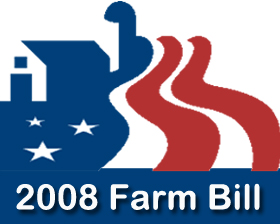
The Great Society was a set of domestic programs in the United States launched by President Lyndon B. Johnson in 1964 and 1965. The term was first referenced during a 1964 speech by Johnson at Ohio University, then later formally presented at the University of Michigan, and came to represent his domestic agenda. The main goal was the total elimination of poverty and racial injustice.

The United States Department of Agriculture (USDA) is the federal executive department responsible for developing and executing federal laws related to farming, forestry, rural economic development, and food. It aims to meet the needs of commercial farming and livestock food production, promotes agricultural trade and production, works to assure food safety, protects natural resources, fosters rural communities and works to end hunger in the United States and internationally. It is headed by the Secretary of Agriculture, who reports directly to the President of the United States and is a member of the president's Cabinet. The current secretary is Tom Vilsack, who has served since February 24, 2021.

In the United States, the Supplemental Nutrition Assistance Program (SNAP), formerly known as the Food Stamp Program, is a federal government program that provides food-purchasing assistance for low- and no-income people to help them maintain adequate nutrition and health. It is a federal aid program administered by the U.S. Department of Agriculture (USDA) under the Food and Nutrition Service (FNS), though benefits are distributed by specific departments of U.S. states.
The Child Nutrition Act of 1966 (CNA) is a United States federal law (act) signed on October 11, 1966 by President Lyndon B. Johnson. The Act was created as a result of the "years of cumulative successful experience under the National School Lunch Program (NSLP) to help meet the nutritional needs of children." The National School Lunch Program feeds 30.5 million children per day. NSLP was operated in over 101,000 public and nonprofit private schools in 2007. The Special Milk Program, functioning since 1954, was extended to June 30, 1970 and incorporated into the act. The act also provided Federal funding assistance towards non-food purchases for school equipment.

Government cheese is processed cheese provided to welfare beneficiaries, Food Stamp recipients, and the elderly receiving Social Security in the United States, as well as to food banks and churches. This processed cheese was used in military kitchens during World War II and has been used in schools since the 1950s.

Food policy is the area of public policy concerning how food is produced, processed, distributed, purchased, or provided. Food policies are designed to influence the operation of the food and agriculture system balanced with ensuring human health needs. This often includes decision-making around production and processing techniques, marketing, availability, utilization, and consumption of food, in the interest of meeting or furthering social objectives. Food policy can be promulgated on any level, from local to global, and by a government agency, business, or organization. Food policymakers engage in activities such as regulation of food-related industries, establishing eligibility standards for food assistance programs for the poor, ensuring safety of the food supply, food labeling, and even the qualifications of a product to be considered organic.
Nutrition Assistance for Puerto Rico (NAP) —Spanish: Programa de Asistencia Nutricional (PAN) popularly known in Puerto Rico as Cupones — is a federal assistance nutritional program provided by the United States Department of Agriculture (USDA) solely to Puerto Rico. In 2021, over $2 billion USD was appropriated as a block grant for NAP to assist over 1 million impoverished residents of Puerto Rico. It is based on, though not part of, the USDA's national Supplemental Nutrition Assistance Program (SNAP) which in 2018 provided $64 billion in nutritional assistance to 42 million people in the 50 U.S. states, D.C., Guam and the US Virgin Islands.
In different administrative and organizational forms, the Food for Peace program of the United States has provided food assistance around the world for more than 60 years. Approximately 3 billion people in 150 countries have benefited directly from U.S. food assistance. The Bureau for Humanitarian Assistance within the United States Agency for International Development (USAID) is the U.S. Government's largest provider of overseas food assistance. The food assistance programming is funded primarily through the Food for Peace Act. The Bureau for Humanitarian Assistance also receives International Disaster Assistance Funds through the Foreign Assistance Act (FAA) that can be used in emergency settings.

In the United States, the farm bill is the primary agricultural and food policy instrument of the federal government. Every five years, Congress deals with the renewal and revision of the comprehensive omnibus bill.

The Food, Conservation, and Energy Act of 2008 was a $288 billion, five-year agricultural policy bill that was passed into law by the United States Congress on June 18, 2008. The bill was a continuation of the 2002 Farm Bill. It continues the United States' long history of agricultural subsidies as well as pursuing areas such as energy, conservation, nutrition, and rural development. Some specific initiatives in the bill include increases in Food Stamp benefits, increased support for the production of cellulosic ethanol, and money for the research of pests, diseases and other agricultural problems.

In the United States, the Child Nutrition Programs are a grouping of programs funded by the federal government to support meal and milk service programs for children in schools, residential and day care facilities, family and group day care homes, and summer day camps, and for low-income pregnant and postpartum women, infants, and children under age 5 in local WIC clinics.
The Commodity Distribution Program, a program under Section 14 of the Richard B. Russell National School Lunch Act (NSLA), requires the Secretary of Agriculture to use agricultural surplus removal funds and Commodity Credit Corporation (CCC) funds to buy commodities for child and elderly nutrition programs. The Secretary is directed to use Section 32 funds not needed for other purposes and CCC funds to buy commodities for donation to maintain the annually programmed level of commodity assistance for Child and Elderly Nutrition programs mandated by the National School Lunch Act, Child Nutrition Act, and Older Americans Act.

The Food, Agriculture, Conservation, and Trade (FACT) Act of 1990 — P.L. 101-624 was a 5-year omnibus farm bill that passed Congress and was signed into law.
The Emergency Food Assistance Act of 1983 amended the original Temporary Emergency Food Assistance Act of 1983 to authorize multi-year funding and commodity donations from excess Commodity Credit Corporation (CCC) inventories of foodstuffs for food distribution by emergency feeding organizations serving the needy and homeless. It subsequently was amended in 1985, 1988, 1990, 1996 and 2002 under the 2002 farm bill. This is the Emergency Food Assistance and Soup Kitchen-Food Bank Program.

The United States Food and Agriculture Act of 1977 was an omnibus farm bill. The S. 275 legislation was passed by the 95th U.S. Congressional session and signed into law by the 39th President of the United States Jimmy Carter on September 29, 1977.

CalFresh is the California implementation of the federal Supplemental Nutrition Assistance Program (SNAP), formerly known as the Food Stamp program, which provides financial assistance for purchasing food to low-income California residents.

The Agricultural Act of 2014 is an act of Congress that authorizes nutrition and agriculture programs in the United States for the years of 2014-2018. The bill authorizes $956 billion in spending over the next ten years.
This article is intended to give an overview of the welfare system in the U.S. State of New York.

The 2018 farm bill or Agriculture Improvement Act of 2018 is an enacted United States farm bill that reauthorized $867 billion for many expenditures approved in the prior farm bill. The bill was passed by the Senate and House on December 11 and 12, 2018, respectively. On December 20, 2018, it was signed into law by President Donald Trump.
The 1969 White House Conference on Food, Nutrition and Health was a historic first and resulted in landmark legislation. In his opening address on December 2, U.S. President Richard M. Nixon vowed “to put an end to hunger in America…for all time.” The three-day gathering came at the end of a decade of social, cultural, and political change which had resulted in a sudden awareness of the widespread malnutrition and hunger afflicting many poor in the United States. Eight-hundred academics and scientists, business and civic leaders, activists, and politicians developed more than 1,800 recommendations, which were reviewed by the 2,700 conference attendees and delivered in a full report to the President on December 24, 1969. The Supplemental Nutrition Assistance Program, Special Supplemental Nutrition Program for Women, Infants and Children (WIC), National School Lunch Program (NSLP), and the School Breakfast Program (SBP) are among the 1,400 nutrition and food assistance programs and recommendations implemented or improved as a result of the White House Conference. In May 2022, President Joe Biden announced a new White House Conference on Hunger, Nutrition and Health which was scheduled to convene on September 28, 2022 in Washington, D.C.












